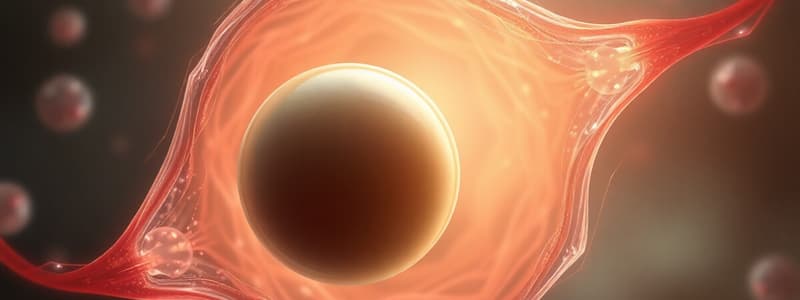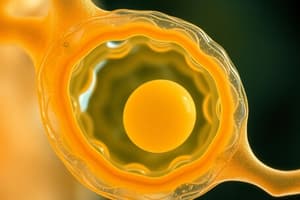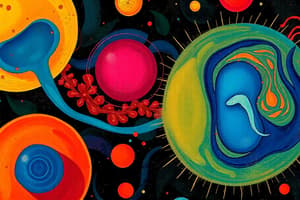Podcast
Questions and Answers
What is the primary function of the Zona Pellucida during fertilization?
What is the primary function of the Zona Pellucida during fertilization?
- It stores nutrients necessary for oocyte development.
- It acts as a barrier against bacterial infection.
- It protects the oocyte from environmental damage.
- It facilitates sperm binding and prevents polyspermy. (correct)
Which process directly leads to the extrusion of the polar body during meiosis?
Which process directly leads to the extrusion of the polar body during meiosis?
- The formation of the germinal vesicle.
- Symmetric division of the oocyte.
- Asymmetric division of the oocyte. (correct)
- The surge of Follicle Stimulating Hormone (FSH).
What triggers the oocyte to resume meiosis just before ovulation?
What triggers the oocyte to resume meiosis just before ovulation?
- Follicle Stimulating Hormone (FSH) increase.
- Gradual decrease in progesterone levels.
- Estrogen levels dropping.
- A surge of Luteinizing Hormone (LH). (correct)
At which stage is the oocyte considered a Metaphase II (MII) oocyte?
At which stage is the oocyte considered a Metaphase II (MII) oocyte?
What happens to the germinal vesicle during meiotic maturation?
What happens to the germinal vesicle during meiotic maturation?
Which protein is specifically involved in meiotic recombination?
Which protein is specifically involved in meiotic recombination?
What is the primary role of FoxL2 in follicle assembly?
What is the primary role of FoxL2 in follicle assembly?
What consequence may result from the absence of key proteins involved in primordial follicle formation?
What consequence may result from the absence of key proteins involved in primordial follicle formation?
At what developmental stage are oocytes arrested during follicle assembly?
At what developmental stage are oocytes arrested during follicle assembly?
When is follicle assembly typically completed in mice?
When is follicle assembly typically completed in mice?
What is the primary function of the ovaries related to hormones?
What is the primary function of the ovaries related to hormones?
What does the ovarian reserve consist of?
What does the ovarian reserve consist of?
Which protein is necessary for the development of oocytes?
Which protein is necessary for the development of oocytes?
During which phase do primordial germ cells become known as oogonia?
During which phase do primordial germ cells become known as oogonia?
What occurs to oogonia after they stop dividing by mitosis?
What occurs to oogonia after they stop dividing by mitosis?
Which protein is involved in cell signaling and regulation within the context of follicle assembly?
Which protein is involved in cell signaling and regulation within the context of follicle assembly?
What marks the formation of a primordial follicle?
What marks the formation of a primordial follicle?
Which statement accurately describes the germ cell nests?
Which statement accurately describes the germ cell nests?
What is the initial developmental stage of female gametes in the ovary called?
What is the initial developmental stage of female gametes in the ovary called?
What is a significant limitation once the primordial follicles have formed?
What is a significant limitation once the primordial follicles have formed?
What is the significance of somatic cells surrounding the oocytes?
What is the significance of somatic cells surrounding the oocytes?
Which process marks the beginning of oogenesis in the developing ovary?
Which process marks the beginning of oogenesis in the developing ovary?
Which marker is NOT expressed by PGCs upon arriving at the gonad?
Which marker is NOT expressed by PGCs upon arriving at the gonad?
What process leads to the formation of germ cell nests in females?
What process leads to the formation of germ cell nests in females?
At what embryonic day do female germ cells begin meiosis in mice?
At what embryonic day do female germ cells begin meiosis in mice?
Which signal is NOT mentioned as influencing female germ cell development?
Which signal is NOT mentioned as influencing female germ cell development?
Which cells continue to proliferate, forming multiple layers around the oocyte in the secondary follicle?
Which cells continue to proliferate, forming multiple layers around the oocyte in the secondary follicle?
What transformation occurs in XY gonocytes around 12.5 days post-conception?
What transformation occurs in XY gonocytes around 12.5 days post-conception?
What is the role of transzonal projections between granulosa cells and the oocyte?
What is the role of transzonal projections between granulosa cells and the oocyte?
Which of the following is primarily responsible for directing female germ cell differentiation?
Which of the following is primarily responsible for directing female germ cell differentiation?
What is the primary role of Stra8 in female germ cell development?
What is the primary role of Stra8 in female germ cell development?
Which statement correctly describes the role of theca cells in follicle development?
Which statement correctly describes the role of theca cells in follicle development?
At what stage is the oocyte when it is meiotically arrested?
At what stage is the oocyte when it is meiotically arrested?
How do male germ cells transition from gonocytes?
How do male germ cells transition from gonocytes?
What happens to the granulosa cells as the follicle develops into the secondary stage?
What happens to the granulosa cells as the follicle develops into the secondary stage?
What key characteristic defines PGCs upon their arrival at the gonad?
What key characteristic defines PGCs upon their arrival at the gonad?
What defines the secondary follicle in terms of oocyte development?
What defines the secondary follicle in terms of oocyte development?
Why is the proliferation of granulosa cells critical for the growing oocyte?
Why is the proliferation of granulosa cells critical for the growing oocyte?
What is the purpose of the zona pellucida during the fertilization process?
What is the purpose of the zona pellucida during the fertilization process?
Flashcards
Oogenesis
Oogenesis
The process by which female gametes (eggs) are formed in the ovaries.
Primordial Germ Cells (PGCs)
Primordial Germ Cells (PGCs)
The precursor cells that will eventually give rise to oocytes (eggs) in females.
PGC Migration
PGC Migration
The movement of primordial germ cells from their site of origin to the developing gonad (ovary or testes).
Oogonia
Oogonia
Signup and view all the flashcards
Germ Cell Nests
Germ Cell Nests
Signup and view all the flashcards
Somatic Cells
Somatic Cells
Signup and view all the flashcards
Somatic Cell Invasion
Somatic Cell Invasion
Signup and view all the flashcards
PGC Morphological Change
PGC Morphological Change
Signup and view all the flashcards
GCNA (Germ Cell Nuclear Antigen)
GCNA (Germ Cell Nuclear Antigen)
Signup and view all the flashcards
SSEA (Stage-Specific Embryonic Antigen)
SSEA (Stage-Specific Embryonic Antigen)
Signup and view all the flashcards
Thy1
Thy1
Signup and view all the flashcards
C-kit
C-kit
Signup and view all the flashcards
Alkaline Phosphatase
Alkaline Phosphatase
Signup and view all the flashcards
Sex Determination
Sex Determination
Signup and view all the flashcards
Meiosis in Female Germ Cells
Meiosis in Female Germ Cells
Signup and view all the flashcards
Retinoic Acid
Retinoic Acid
Signup and view all the flashcards
Key proteins in follicle formation
Key proteins in follicle formation
Signup and view all the flashcards
What does SCP-1 do?
What does SCP-1 do?
Signup and view all the flashcards
What does FoxL2 do?
What does FoxL2 do?
Signup and view all the flashcards
What does Nobox do?
What does Nobox do?
Signup and view all the flashcards
What does Notch do in follicle formation?
What does Notch do in follicle formation?
Signup and view all the flashcards
What happens when key follicle proteins are missing?
What happens when key follicle proteins are missing?
Signup and view all the flashcards
What is follicle assembly?
What is follicle assembly?
Signup and view all the flashcards
Define ovarian reserve.
Define ovarian reserve.
Signup and view all the flashcards
Why is follicle assembly important?
Why is follicle assembly important?
Signup and view all the flashcards
When is follicle assembly completed?
When is follicle assembly completed?
Signup and view all the flashcards
Zona Pellucida
Zona Pellucida
Signup and view all the flashcards
Granulosa Cell Proliferation
Granulosa Cell Proliferation
Signup and view all the flashcards
Transzonal Projections
Transzonal Projections
Signup and view all the flashcards
Theca Cells
Theca Cells
Signup and view all the flashcards
Oocyte Growth in Secondary Follicle
Oocyte Growth in Secondary Follicle
Signup and view all the flashcards
Polyspermy
Polyspermy
Signup and view all the flashcards
Oocyte Maturation
Oocyte Maturation
Signup and view all the flashcards
Germinal Vesicle (GV) Stage
Germinal Vesicle (GV) Stage
Signup and view all the flashcards
Luteinizing Hormone (LH) Surge
Luteinizing Hormone (LH) Surge
Signup and view all the flashcards
Cumulus Cells Expansion
Cumulus Cells Expansion
Signup and view all the flashcards
Polar Body Formation
Polar Body Formation
Signup and view all the flashcards
Study Notes
Female Developmental Reproduction
- The ovary has three main functions:
- Making hormones, impacting pregnancy and secondary sexual characteristics
- Storing female germline, protecting it from chemical and physical insults, and maintaining quiescence
- Generating mature oocytes, crucial for fertility and species perpetuation
Oogenesis
- Process of forming female gametes (oocytes) within the ovaries
- A lengthy process, beginning in fetal development and concluding decades later in adulthood
- Takes considerable time to produce an oocyte
Part 1: Development of Oocytes in the Embryonic Ovary
-
Development from primordial germ cells (PGCs) to primordial follicles
- PGC specification occurs early in embryonic development, specifying precursor cells for oocytes (in females) or sperm (in males)
- PGCs undergo mitosis and migrate to increase their numbers, eventually reaching the developing gonads (ovaries).
- Once in the gonad, they are called gonocytes and then oogonia.
- Oogonia multiply and form germ cell nests.
- Somatic cells surround these nests, supporting germ cell development.
- Oogonia then enter meiosis, becoming oocytes.
- Somatic cells envelop oocytes, forming primordial follicles.
-
Arrest during meiosis: oocytes arrest in the diplotene stage of the first meiotic prophase.
-
Formation of primordial follicles: a single layer of granulosa cells surrounds the oocyte.
Timeline of Germ Cell Development in Mice
- Development from embryonic day 6 to postnatal day 5
Comparison Between Mice and Humans
-
Synchronization: Mice have synchronized oogenesis, while human oogenesis is not synchronized. This means stages of germ cell development overlap.
-
Follicle Timing: Follicle formation is completed postnatally in mice, while it happens before birth in humans.
Oogenesis Stages: Mice vs. Humans
- Timing - In mice, it is synchronous, while in humans, it is asynchronous.
Timing of Follicle Formation
- In mice – completed shortly after birth
- In humans – completed during fetal development
Formation of Primordial Germ Cells: Origin and Initial Population
- Primordial germ cells originate in the proximal epiblast, an early embryonic layer.
- Start with about 6 cells around embryonic day 6.25 in mice, growing to approximately 40 cells by day 7.25.
Characteristics of Newly Specified PGCs
- Smooth morphology when stationary
- Transcriptionally active - expressing genes required for function and identity.
- Suppressing somatic lineage genes via Blimp1.
PGC Migration
-
Migration begins around embryonic day 7.5 in mice.
-
PGCs migrate from the primitive streak to the yolk sac, then through the endoderm hindgut, eventually reaching the genital ridge/gonadal ridge around embryonic day 10.5
-
Signalling pathways: important factors for migration include SDF-1 and CXCR4 and changes in cytoskeleton.
Changes Upon Arrival
- Loss of polarity in morphology
- Cessation of migratory behavior.
Morphological Change
- Transition to large, round cells with a large, round nucleus, expressing specific markers such as GCNA and Thy1.
Loss of Alkaline Phosphatase
Prophase I of Meiosis
- Divided into five steps: Leptotene, Zygotene, Pachytene, Diplotene, and Diakinesis.
Arrested Development
- In males, spermatogonia continue meiosis toward sperm cells.
- In females, primary oocytes arrest in diplotene.
Importance of Meiotic Recombination
- Generates genetic diversity.
Nest Formation
- Oogonia undergo incomplete cytokinesis, remaining clustered in nests.
- Crucial for nutrient and material transfer to support growth.
Nest Breakdown
- Breakdown occurs around birth in mice or mid-gestation in humans.
- Involvement of pre-granulosa cells, formation of individual primordial follicles.
Follicle Assembly
- Granulosa cells surrounding oocytes, forming primordial follicles.
Ovarian Reserve
- Primordial follicles represent the entirety of oocytes available for fertilization throughout a female's lifetime.
Loss of Proliferative Ability
- Once oocytes enter meiosis, they lose their ability to divide or increase in number.
Part 2: Development of Oocytes in the Postnatal Ovary
Primary Follicle
- Characterized by a growing oocyte and columnar granulosa cells proliferating.
Secondary Follicle
- Oocyte growth continues.
- Zona pellucida forms.
- Granulosa cells proliferate, forming multiple layers around the oocyte.
Tertiary/Antral Follicle
- Formation of the antrum (fluid-filled cavity).
- Granulosa cells differentiate into mural and cumulus cells.
Graafian Follicle
- FSH and LH stimulate further growth, estradiol production.
Cyclic FSH Release
Cumulus Oocyte Complex and Germinal Vesicle Stage
- Oocyte preparation for final stages of meiosis
Meiotic Maturation
- Completion of meiosis I and II, polar bodies, one mature ovum.
- LH surge triggers meiotic resumption.
Ovulation
- Release of the cumulus-oocyte complex.
- Formation of corpus luteum from remnants of the follicle (crucial for maintaining uterine lining and supporting pregnancy).
Time Course of Follicle Development
- Specific timeframes for each stage are diverse, varying by species.
Consequences of Absence
- Inability of primordial follicles to form, impacting fertility.
First Natural Ovulation
- gentle versus explosive release.
Studying That Suits You
Use AI to generate personalized quizzes and flashcards to suit your learning preferences.




